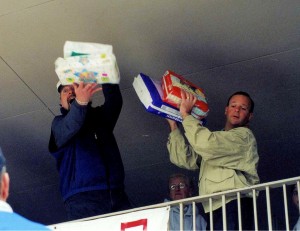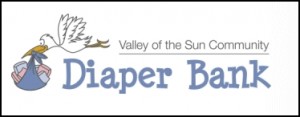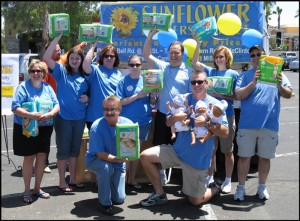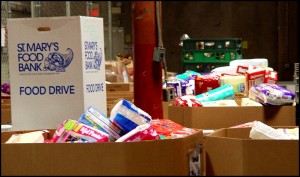This is Post #3 in a five-part series, honoring the release of the 2nd Edition of FriendRaising.
To read this series from the beginning, head here.
In that series, I’m highlighting stories from the book – stories of our days building the first-ever community-wide Diaper Bank, in Tucson, Arizona!)
Today’s story comes from the turning point, the moment when the annual charitable effort of our small consulting firm made it very clear that it had outgrown us. If there was a single moment when we knew this effort needed to morph from an annual diaper drive, to become a year-round, serving-the-whole-community Diaper Bank – this was that moment.
Volunteer Parties:
(From FriendRaising page 70)…
In the days of the American frontier, when someone needed to build a barn, neighbors would gather to make that chore go far more quickly than any one family could do on its own. What might otherwise take weeks to complete could be done in a day.
Perhaps the modern-day equivalent of a barn-raising would be having friends over to paint your house, or to help you move. When a task is turned into a social event, it is no longer work. It becomes instead the best kind of party – the kind where folks naturally get to know each other, without any pressure.
While this type of event works well for any volunteer need, if the task requires manual labor, that is when the real fun begins. Grown-ups do not typically have the opportunity to gather with other grown-ups and get dirty and sweaty, especially in a setting where it is all for a good cause. And like the barn-raising in days of old, nothing builds bonds faster than a group of people all pitching in together.
The Diaper Hurl
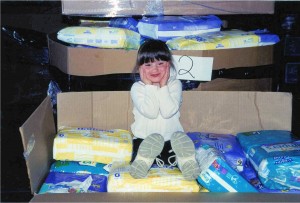 At the Diaper Bank, the event most people calendared a year in advance was not a gala, but our Annual Hurling Party.
At the Diaper Bank, the event most people calendared a year in advance was not a gala, but our Annual Hurling Party.
In 1998, our 5th Annual December Diaper Drive collected almost twice what we had ever collected before – over 300,000 diapers.
The diapers had arrived via individual donors carrying their individual packages up the stairs to our 2nd story walk-up office. Package by package, the diapers slowly piled up. Eventually they overran our tiny office.
So how do you get 300,000 diapers out of the office and delivered to the recipient agencies? The thought of marching each of those packages back out of our office and down the stairs was unbearable.
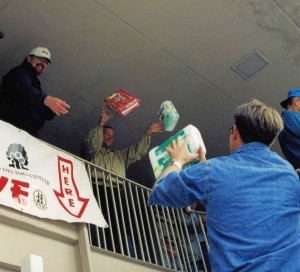 Sitting shoulder-deep in diapers as we considered our options, giddiness set in. “Can’t we just toss these things over the balcony and be done with them?” we asked ourselves. I remember telling a friend on the phone, “We’ve got so many diapers in here, I am ready to hurl.”
Sitting shoulder-deep in diapers as we considered our options, giddiness set in. “Can’t we just toss these things over the balcony and be done with them?” we asked ourselves. I remember telling a friend on the phone, “We’ve got so many diapers in here, I am ready to hurl.”
And down to the words, that is just what we did. The invitations read, “We’ve got so many diapers, we are ready to hurl!”
The morning of the Hurling Party, a volunteer crew from Tucson Electric Power backed TEP’s huge flatbed trucks underneath our balcony.
Joining those community members were radio personalities, City Council members, donors, family and friends, who stationed themselves on the backs of those trucks, while another crew was positioned upstairs.
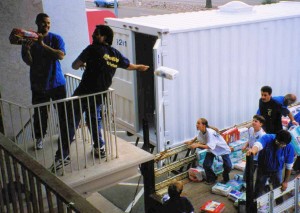 Before we began working, I gave a short talk. “While we are here today to hurl diapers,” I started, “I want to remind you all that this is not about diapers. This is about people who cannot help themselves – people with disabilities, the elderly, and of course babies. This is about poverty and vulnerability, and the need for us to do far more than just help with their diapers. As you handle these thousands of diapers today, please take a moment to think about why you are doing this, why we are all doing this.”
Before we began working, I gave a short talk. “While we are here today to hurl diapers,” I started, “I want to remind you all that this is not about diapers. This is about people who cannot help themselves – people with disabilities, the elderly, and of course babies. This is about poverty and vulnerability, and the need for us to do far more than just help with their diapers. As you handle these thousands of diapers today, please take a moment to think about why you are doing this, why we are all doing this.”
Then, with news cameras on hand to document the scene, we bucket-brigaded the diapers out of our office and towards the balcony.
And we hurled those diapers into the waiting hands of the crews on the trucks.
Within just an hour and a half, all 300,000 diapers were off to the agencies who would provide them to clients. And a beloved annual event was born!
Tomorrow, I’ll continue this series with some insights into house parties and coffee – and how that all relates to diapers, and friendship, and making a difference. You’ll find that post here.
To read more from FriendRaising, click here to download portions as a PDF.
